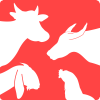Training: Perbedaan revisi
| Baris 2: | Baris 2: | ||
=Training resources= | =Training resources= | ||
| − | {{fpblock|Field Epidemiology|Themes256.png|The training in field epidemiology has been developed to provide veterinary and para-veterinary field staff with the skills required to collect high quality surveillance data, and to make better decisions on the basis of the data collected.}} | + | {{fpblock|Field Epidemiology|Themes256.png|The training in field epidemiology has been developed to provide veterinary and para-veterinary field staff with the skills required to collect high quality surveillance data using a broader range of information about disease within the population, and to make better treatment and prevention decisions on the basis of the data collected.}} |
| − | {{fpblock|Surveillance|Disease_map_example_from_iSIKHNAS.png|The training has been developed in two individual courses. The basic surveillance course has been designed for | + | {{fpblock|Surveillance|Disease_map_example_from_iSIKHNAS.png|The training has been developed in two individual courses. The basic surveillance course has been designed for para-veterinarians and to act as a refresher course for veterinarians in the skills required to collect high quality surveillance data, and to make better decisions on the basis of the data collected. The advanced surveillance course has been designed for training of veterinarians in more advanced surveillance skills.}} |
{{fpblock|Budget Advocacy|Sales-report256.png|For Indonesian government staff who have responsibilities for preparing budgets requests, to be able to use analyses of animal health data together with animal health economics skills to support budget advocacy for improving animal health in Indonesia. | {{fpblock|Budget Advocacy|Sales-report256.png|For Indonesian government staff who have responsibilities for preparing budgets requests, to be able to use analyses of animal health data together with animal health economics skills to support budget advocacy for improving animal health in Indonesia. | ||
In order to achieve this they will need to be able to: | In order to achieve this they will need to be able to: | ||
| − | * | + | *Understanding motivations, planning, communicating and presenting data in a persuasive |
*Describe how performance indicators can be used to measure progress or achievements of goals and how this data can support budget requests | *Describe how performance indicators can be used to measure progress or achievements of goals and how this data can support budget requests | ||
*Use iSIKHNAS data to estimate the cost of disease, estimate benefits from proposes animal health activities, and justify the proposed budget request.}} | *Use iSIKHNAS data to estimate the cost of disease, estimate benefits from proposes animal health activities, and justify the proposed budget request.}} | ||
| Baris 23: | Baris 23: | ||
{{fpblock|Excel|Upline256.png|This course was first conducted in May 2013, prior to iSIKHNAS development. It will be undergoing revision to incorporate the use of data accessible through iSIKHNAS.}} | {{fpblock|Excel|Upline256.png|This course was first conducted in May 2013, prior to iSIKHNAS development. It will be undergoing revision to incorporate the use of data accessible through iSIKHNAS.}} | ||
| − | {{fpblock|Disease Investigation|Order-history256.png|This is a practical course for para-vets and other field staff in a range of tasks including | + | {{fpblock|Disease Investigation|Order-history256.png|This is a practical course for para-vets and other field staff in a range of tasks including animal restraint, clinical examination, sample taking and handling, and the taking of a good case history.}} |
| − | {{fpblock|Recognising Signs of Poor Health|Cow 1.jpg|This course has been designed specifically for Pelsa (village reporters) who play a vital role at the village level in communicating health problems both general and priority in nature through the iSIKHNAS system. This course assists Pelsa in the recognition of abnormal signs | + | {{fpblock|Recognising Signs of Poor Health|Cow 1.jpg|This course has been designed specifically for Pelsa (village reporters) who play a vital role at the village level in communicating health problems both general and priority in nature through the iSIKHNAS system. This course assists Pelsa in the recognition of abnormal signs and priority syndromes as well as the simple reporting mechanisms and benefits provided by the iSIKHNAS system.}} |
{{fpblock|Facilitation Guide|Nuvola_apps_edu_miscellaneous.png|This is a comprehensive guide for all staff preparing to facilitate a course, give a presentation or indeed give any kind of training. It has many practical tips and advice which should improve anyone's presentation or course.}} | {{fpblock|Facilitation Guide|Nuvola_apps_edu_miscellaneous.png|This is a comprehensive guide for all staff preparing to facilitate a course, give a presentation or indeed give any kind of training. It has many practical tips and advice which should improve anyone's presentation or course.}} | ||
Revisi per 13 Maret 2014 08.47
Daftar isi
Training resources
Field Epidemiology
The training in field epidemiology has been developed to provide veterinary and para-veterinary field staff with the skills required to collect high quality surveillance data using a broader range of information about disease within the population, and to make better treatment and prevention decisions on the basis of the data collected.
Surveillance
The training has been developed in two individual courses. The basic surveillance course has been designed for para-veterinarians and to act as a refresher course for veterinarians in the skills required to collect high quality surveillance data, and to make better decisions on the basis of the data collected. The advanced surveillance course has been designed for training of veterinarians in more advanced surveillance skills.
Budget Advocacy
For Indonesian government staff who have responsibilities for preparing budgets requests, to be able to use analyses of animal health data together with animal health economics skills to support budget advocacy for improving animal health in Indonesia. In order to achieve this they will need to be able to:
- Understanding motivations, planning, communicating and presenting data in a persuasive
- Describe how performance indicators can be used to measure progress or achievements of goals and how this data can support budget requests
- Use iSIKHNAS data to estimate the cost of disease, estimate benefits from proposes animal health activities, and justify the proposed budget request.
Epidemiological Data Analysis
National, provincial and kabupaten level animal health staff with responsibility for the use of data and epidemiological analysis.
Level 1; a senior district veterinarian with basic computer skills Level 2; a higher level veterinarian (e.g. national level) with higher level computer skills.
GIS for Animal Health
The courses will be based on open-source free powerful GIS software (Quantum GIS). An introductory stage of the course will provide participants with basic disease mapping skills – learning how to use the software to generate usable disease distribution maps based on simple existing data sources in iSIKHNAS. A second stage of the course will develop more advanced skills in GIS and data management using Quantum GIS, PostgreSQL, GRASS and other tools. This course is still focused primarily on disease mapping but moves into more sophisticated techniques.
Excel
This course was first conducted in May 2013, prior to iSIKHNAS development. It will be undergoing revision to incorporate the use of data accessible through iSIKHNAS.
Disease Investigation
This is a practical course for para-vets and other field staff in a range of tasks including animal restraint, clinical examination, sample taking and handling, and the taking of a good case history.
Recognising Signs of Poor Health
This course has been designed specifically for Pelsa (village reporters) who play a vital role at the village level in communicating health problems both general and priority in nature through the iSIKHNAS system. This course assists Pelsa in the recognition of abnormal signs and priority syndromes as well as the simple reporting mechanisms and benefits provided by the iSIKHNAS system.
Facilitation Guide
This is a comprehensive guide for all staff preparing to facilitate a course, give a presentation or indeed give any kind of training. It has many practical tips and advice which should improve anyone's presentation or course.
Pelsa (Pelapor Desa - Village reporters)
Priority Disease Investigation










